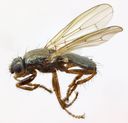Kelp Flies
Coelopidae
Classification
- Phylum: Arthropoda
- Subphylum: Hexapoda
- Class: Insecta
- Order: Diptera
- Superfamily: Sciomyzoidea
- Family: Coelopidae
Pronunciation
How to pronounce Coelopidae: //siːˈlɒpɪdiː//
These audio files are automatically generated. While they are not always 100% accurate, they are a good starting point.
Images






Summary
The Coelopidae, or kelp flies, are a family of small to medium-sized flies that inhabit coastal zones, feeding on decaying kelp. With fewer than 40 species worldwide, they play a critical role in coastal ecosystems through the decomposition of organic matter.
Physical Characteristics
Coelopids are small to medium-sized flies ranging from 2.5 to 9 mm in length, predominantly with a flat body and dark coloration. They exhibit a densely bristly or hairy appearance, small eyes, and a wing that is unmarked. The body has notable features such as the absence of vibrissae, presence of ocelli, and parallel or converging postvertical bristles. Their legs are hairy with bristles, and the tibiae have subapical bristles.
Identification Tips
Identification can be made based on body size (usually 4-7 mm), robust build, and distinctive bristly appearance. Examination of the wing structure and bristle arrangement on the head and legs can aid in distinguishing them from other flies.
Habitat
Coelopidae are primarily found in the wrack zone of temperate coastal seashores where decaying seaweed, specifically kelp, is abundant.
Distribution
The family is found in temperate regions worldwide, especially in the southern Afrotropical, Holarctic, and Australasian areas, with the highest species diversity found in Australasia.
Diet
Larvae of Coelopidae feed on rotting seaweed in a bacteria-laden mass, contributing to the decomposition of organic matter in their habitat.
Life Cycle
Coelopids undergo several generations in a year, with females laying eggs in small batches on fresh algal banks. They have three larval instars before pupation.
Reproduction
Females lay eggs in small batches within fresh algal banks. The larvae develop through three instars before pupating, often seeking shelter in the upper sand layers rather than in the collapsing algal substrate.
Predators
Larvae and pupae are preyed upon by birds and staphylinids like Aleochara, as well as various parasitic species that inhabit algal banks.
Ecosystem Role
Coelopidae play a role in the coastal ecosystem by participating in the decomposition of organic matter, specifically decaying seaweed, and serve as food for various predators.
Misconceptions
The term 'seaweed flies' is often used interchangeably with kelp flies, which can be misleading as it refers to multiple different seashore Diptera, not exclusively the Coelopidae family.
Tags
- Coelopidae
- Kelp Flies
- Diptera
- Coastal Habitat
- Decomposers